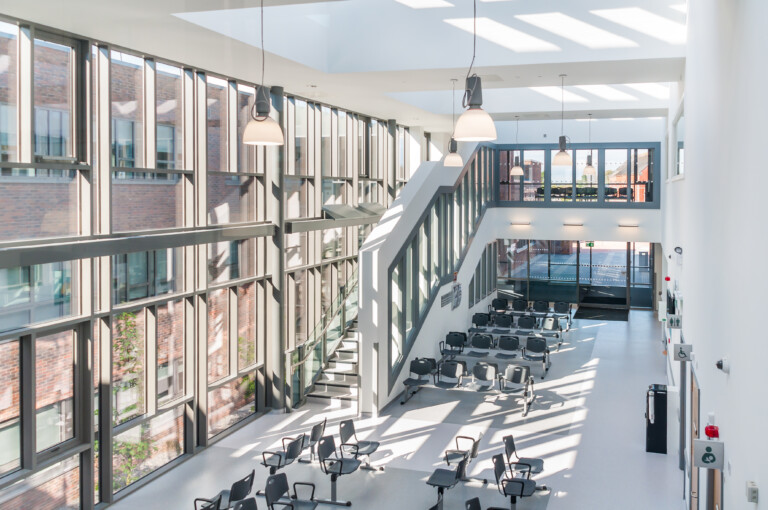The “healthy” built environment – balancing wellbeing, comfort and sustainability.

What do healthcare facilities of the future look like? How can we balance the drive towards net zero whilst making such environments “healthier” by incorporating features such as good indoor air quality, natural light, access to green spaces and reduced noise pollution? Overall, a focus on health and wellbeing can improve the hospital experience for patients, staff and visitors alike but can we still achieve this while maintaining low-energy consumption and achieving sustainability goals?
Balancing wellbeing and sustainability
You have to find a balance between several potentially competing objectives: to create a safe, natural, comfortable environment for patients and to minimise the building’s environmental impact through the use of sustainable and energy-saving technologies.
Healthcare facilities have an important role to play in providing comfort, care and treatment to those who are often at their most vulnerable and in need of a healing environment. Their primary goal being to improve the patient and staff experience through various aspects of the built environment. A well-designed healthcare facility should prioritise the comfort and wellbeing of building users, creating an environment that supports health creation. Additionally, prioritising the wellbeing of staff can improve patient outcomes by reducing turnover and absenteeism.
At the same time, with the growing concern over climate change and the need to reduce energy consumption, there has been a push towards designing and building facilities that are not only functional but energy efficient and environmentally friendly. Couple this with meeting the requirements of Health Technical Memoranda (HTMs), Health Building Notes (HBNs) and infection prevention and control, you have to find a balance between several potentially competing objectives: to create a safe, natural, comfortable environment for patients and to minimise the building’s environmental impact through the use of sustainable and energy-saving technologies.
Net Zero and the NHS
Understanding and reducing embodied and operational carbon to provide an optimum whole life carbon approach is key to achieving the NHS commitment to deliver a net zero health service by 2045 and the recently published NHS Net Zero Building Standard lays the foundations for delivering a net zero NHS, whilst acknowledging the need to improve patient care.
As the Standard recognises, “Improving energy performance is an investment in patient and staff health and wellbeing, as it leads to warmer, more comfortable buildings with better air quality, when paired with adequate ventilation”. Environmental sustainability, occupant comfort and wellbeing, and social responsibility are at the heart of this new guidance with a focus put on passive design measures to assess opportunities for energy reduction and mitigate unintended design consequences. Key in this is adopting a holistic approach to sustainability where user health and wellbeing through thermal comfort, light and views, including natural light, air quality, acoustics and noise pollution reduction is embedded into a project at the earliest opportunity.
A personal reflection on sustainable healthcare
The importance of “healthy healthcare” can be explored through the personal story of Jamie Brewster, an architect at DB3 Architecture and long-time friend of Prime’s. Jamie’s experience[1] as an inpatient in an acute hospital setting provides a unique opportunity to observe the inpatient environment and the impact it has on patients and their recovery.
“Having been an inpatient in an acute hospital receiving treatment for leukaemia I was able to make a series of observations about the nature of the inpatient environment and whether there is a need for improvement. The care I received during several inpatient stays was exemplary but perhaps diminished by the quality of the environment within which treatment was being delivered. I wanted to do something about this.
The issues I was unable to have direct control over related to the most basic of human sensory phenomena”
Architect Jamie Brewster on his experience as an inpatient
During my stay, the overriding theme describing my experience is control, or more pertinently, the lack of it. I experienced several aspects which contributed to the quality of my stay and affected my treatment, recovery and recuperation. The ‘symptoms’ I experienced might have been even more felt by other inpatients who were older and less fit than myself. Some fundamental aspects relating to the quality of the inpatient environment continue to manifest, despite there being countless studies, guidance documents and papers written attempting to offer solutions. This is not a new issue but is one which is still problematic and continues to challenge those responsible for designing, building and delivering inpatient care.
The issues I was unable to have direct control over related to the most basic of human sensory phenomena – what I could hear (noise), what I could feel (temperature), what I could smell (ventilation) and what I could see (view). My growing frustration regarding these fundamentals led me to wonder why I couldn’t obtain control and whether the obstacles preventing it could and should be challenged. The importance of control cannot be underestimated when considering the mind-set of an inpatient.
Whilst there are exceptions, in most cases a person has no choice but to become an inpatient in order to obtain necessary treatment and, having been admitted, rightly surrenders almost all aspects of control to those providing care. The ability to be in charge of where one resides, when one sleeps, what and when one eats and who might be around them throughout the day/night is taken away from a patient in order that treatment and recovery can be best achieved. To then also remove control over some basic environmental factors, such as the ability to open a window, would seem to add to the difficulty in experiencing inpatient care and have an adverse impact on the effectiveness of treatment and speed of recovery.”
Conclusion
Achieving net zero in healthcare buildings is a challenge that requires significant technical expertise and innovation. However, it is equally essential to ensure that such requirements do not come at the expense of the patient experience and the quality of spaces and facilities. By seeing net zero compliance and the creation of a healing environment as two interrelated objectives, we can work towards achieving both. The challenge ahead of us is significant, but it is also an opportunity to create sustainable, comfortable and healing spaces for patients and healthcare providers. As we move forward, we must keep this goal in mind and ensure that we strike the right balance between technical compliance and human-centred design.
References
[1] Thoughts on the Inpatient Environment – DarntonB3 (db3group.com)
Prime PLC are a UKGBC member.
Learn more about the work they do here. The header image is from the Waterford Primary Care Centre in Ireland, a Prime Developments project.
Related
How the urban heat island effect makes cities vulnerable to climate change

Addressing fuel poverty with data-driven retrofits

Live, breathe and mean your approach to sustainable development if you want to achieve it

We must deliver a just transition to net zero


